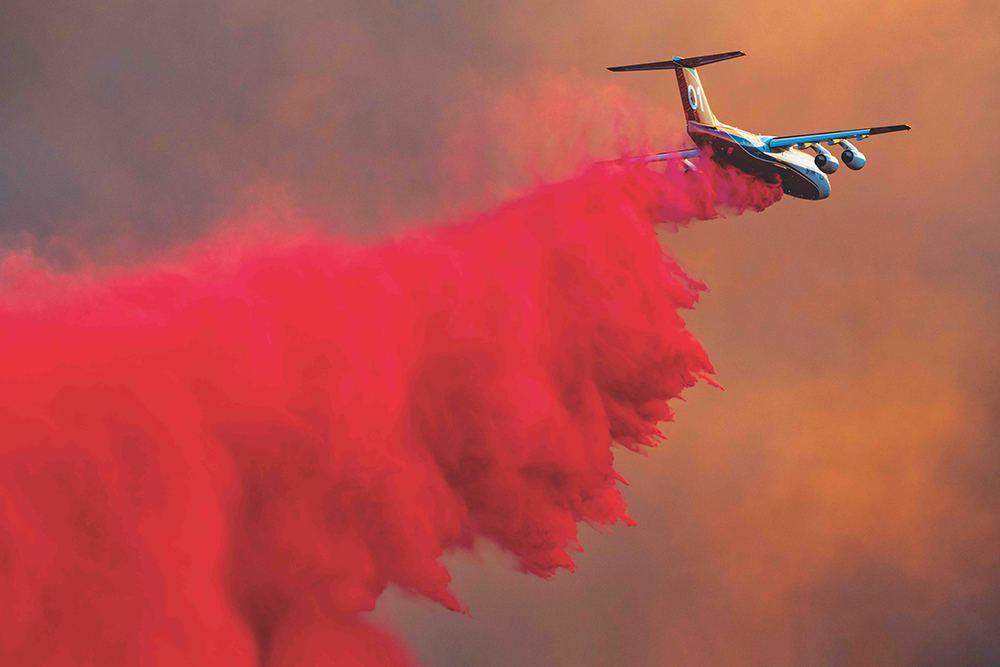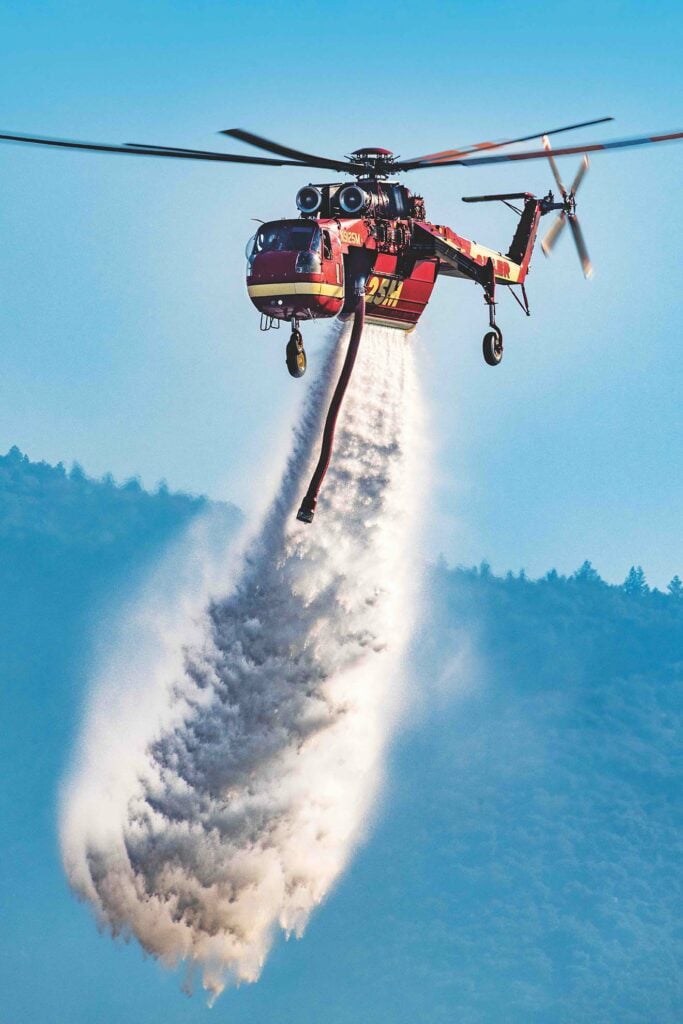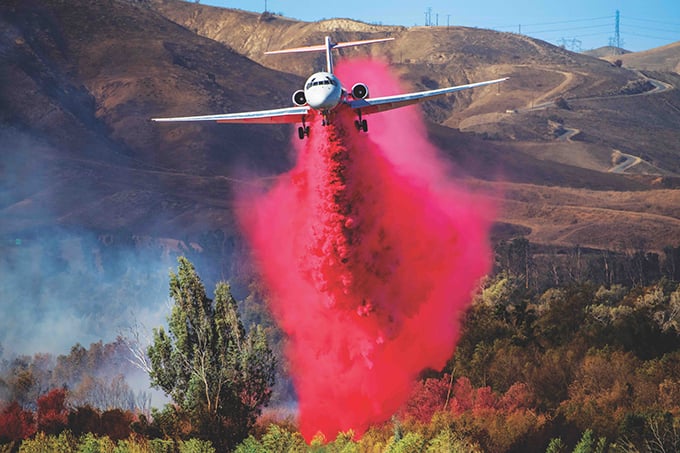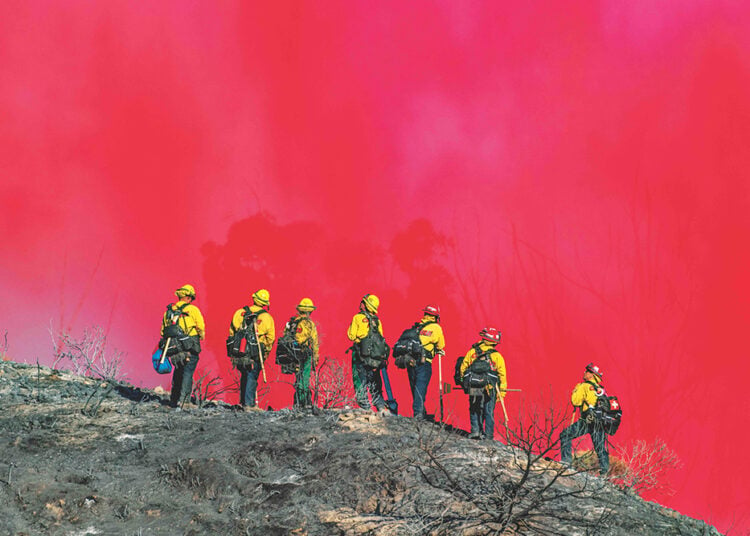During my 35 years as a wildland firefighter, I've been involved and privy to many stories about near-death experiences. Those stories often involved ground firefighters being hit by a portion of 27 thousand pounds of retardant dropped at 150 knots or firefighting aircraft hitting wires and losing half their tails. It is sadly true that wildland firefighters have been seriously injured or killed during aerial operations from retardant and water drops.
I have known some lucky firefighters who found themselves disoriented with the wind knocked out of them. When they opened their eyes, they were tossed down the line, coated with retardant or water and wearing whatever was next to them, like a fire engine or a tree. I say lucky because they have survived to talk about it. Sadly, as of 2018, the wildland fire service has endured a documented firefighter fatality due to a tree strike due to an air tanker drop.
Firefighter safety under aerial operations has long been described as lying face down in the dirt with your head covered, facing the airdrop, and with your tool out to the side. Seventeen years ago, I transitioned from fighting fires from the ground to fighting fires from the air. Having done both, I now realize how much more there is to surviving during the aerial firefight. Employing this knowledge will assist those of us engaged during the aerial firefight. It also will make it easier and safer for aerial firefighters to support ground operations.
Every aerial firefighter's goal is to provide the safest and most effective operation possible to support ground firefighters and their tactics. To be safe means having good communication; knowing the location of other aircraft and ground hazards such as wires, towers, and snags; being aware of firefighter locations; having clear operational objectives, and achieving safe drop heights. To be effective means having the optimal drop: no shadowing, continuous line, no trenching, good canopy penetration, appropriate coverage level, and a line that holds as well as can be expected.
So why should ground firefighters contact and communicate with the air tactical group supervisor (ATGS) or helicopter coordinator (HLCO) commanding the aerial firefight or aircraft over the fire? The answer is simple: aerial firefighters are overhead with a bird's eye view of the battle. We can advise ground crews about fire behavior, rate of spread, size, location, and access, equipment that may need to be ordered or canceled. We can identify secondary lines and any other tactical questions those on the ground might have. What's more, we're around when someone gets into trouble and needs help. We can direct additional support to the site.
We in the air need help with the identification of aerial hazards or communication about something hanging out of place on the aircraft or falling from an airplane. Aerial firefighters have come in contact with ground hazards such as power and/or telephone wires, poles and towers, antennas, cables strung across canyons and creeks, other aircraft, brush and trees, and large snags hidden by smoke. And all these ground hazards need to be communicated to aerial firefighters.
So how are the ATGS, lead planes, air tankers, or helicopters contacted? All aircraft have guarded radio frequencies, meaning the channel may not be muted. Typically two guarded channels are being monitored by those of us in the air. The first guarded channel for most agencies is AIR GUARD. A frequency that never changes in firefighting aircraft should only be used as a hailing frequency.
The second guarded frequency is usually the assigned AIR to GROUND. This frequency is typically assigned by region and may change from one fire to another.
The air-to-ground is the most appropriate frequency to contact someone in the air and should continually be monitored. If ground crews choose not to monitor the air to ground, they gamble the ATGS will be able to find them for directions or to identify a hazard.
The ATGS monitors up to five or six radios simultaneously and may be saturated, prioritizing which ones to answer. This makes it essential always to announce the frequency when calling an aircraft.
![]()
 So what does it look like when we are not safe and effective?
So what does it look like when we are not safe and effective?
Aircrews' and firefighters' safety considerations must be realized and communicated as needed. To prevent firefighter injuries or fatalities in retardant drops, the load of retardant delivered by type 1 and 2 air tankers must be dropped from an altitude of 150 feet, very large air tankers at 200 feet above the tallest vegetation as per policy and contract. This helps secure the safety of aerial and ground firefighters, as the proximity to vegetation and terrain may affect pilots' reaction time. Make no mistake; helicopters have also injured firefighters from water drops.
The drop height is critical not only to ground crew and pilot safety but also to drop effectiveness. We have observed over many years a propensity to drop lower when things appear to need to be fixed as well as expected. As we say in the air world, "On line, on target does not always mean we are being effective."
If the wind blows so hard that the retardant is ineffective, ask yourself, "Should we be asking aircrews to perform this mission?" I would challenge you to proactively raise this question with the incident commander or the ATGS. Although a difficult decision, this is an excellent time to think about halting air operations over that part of the incident.
So how does one know if a retardant drop will be effective? First, we must understand what happens to the retardant when it leaves the aircraft. The retardant in the aircraft travels at the same speed as the aircraft. When the doors open, the retardant is forced out by gravity or air pressure, depending on the drop system. Once it exits the aircraft, the retardant starts to slow down as it hits the air stream, breaking up from a large mass to smaller droplets. The ideal goal is for all of the retardant to impact the drop area as a gentle rain, straight down without forward motion.
Retardant raining straight down will allow for the evenest penetration into the fuel canopy, allowing for the best coverage of the fuel load. Retardant carried forward into the canopy, on the other hand, will account for what is called shadowing, where only one side of the fuel is covered, and the other side is left untouched as the remainder of the retardant passes by. It would be equivalent to spraying someone straight on with a hose. The person would only get wet where the stream impacts them, whereas if one were to point it up in the air and let it rain down, there would be a more three-dimensional coverage.
 To determine if the forward motion of the drop has been stopped, we need to look at the leading edge of the drop. If a wall of uneven gaps is seen, forward motion is likely left in the retardant. Heads cause these gaps, or individual fists of retardant carried forward with such velocity that the air has not sheared them to stop their forward momentum. Here are some pictures to help illustrate drop dynamics.
To determine if the forward motion of the drop has been stopped, we need to look at the leading edge of the drop. If a wall of uneven gaps is seen, forward motion is likely left in the retardant. Heads cause these gaps, or individual fists of retardant carried forward with such velocity that the air has not sheared them to stop their forward momentum. Here are some pictures to help illustrate drop dynamics.
Now that we understand drop dynamics, we can talk about effectiveness. Not all drops will be effective, and many variables must be considered when evaluating the result. If the drop did what you expected, it was effective. If not, then what happened? The first thing to assess is the coverage level used on the drop -- the amount of retardant used. This "coverage level" is figured by the number of gallons dispersed over 100 square feet -- a 10-foot by 10-foot square. If we want coverage level 1, we will figure 1 gallon of coverage in 100 square feet, coverage level 2 equaling 2 gallons per 100 square feet, and so on. The basic starting points for determining adequate coverage levels are as follows:
- Coverage levels 1-2 are good for grass.
- Coverage levels 3-4 are good for grass/brush
- Coverage levels 4-5 are good for brush
- Coverage levels 6-8 are good for brush and timber
Sometimes, the fuel load and fire behavior are such that no amount of retardant would stop the fire. What may be forgotten is that retardant is called retardant because that is what we are using it to do -- otherwise, we would call it fire putter-outer, and our name for that is a firefighter. Other indications of an inadequate drop include but are not limited to the following:
- Scalloping, where there are thin spots and thick spots in the retardant line. This may happen due to a bad overlap of retardant drops or crosswinds.
- Shadowing, where retardant is dropped with too much forward airspeed into the canopy. The drop height needs to be raised.
- Too much drift due to wind, where the retardant drifts down range where it will not be useful.
- The line is too narrow, which may be a sign the tanker was too low, or the fuel load and burning conditions are such that it may need a double wide line.
- Soil and vegetation are physically disturbed (including broken branches), which is a definite sign that the tanker was too low.
- Retardant not penetrating the canopy. This is difficult to overcome, but a lower viscosity retardant or a heavier coverage level may increase penetration. Request a heavier coverage level.
- The consequences of ineffective drops may eventually be compounded if corrections are not made and communicated to the aerial firefighters, with these potential results:
- Burn through
- Larger fires require more drops
- Increased exposure to both ground and aerial firefighters
- Increased potential for firefighter injury
- Damage to equipment and firefighters
The safety of ground personnel is paramount. There are several ways in which firefighters on the ground should know when a retardant drop is imminent. One may be radio advisement from the ATGS or tanker pilot. A second may be a dry run by a lead plane, which leads the air tanker through the drop, or the air tanker itself. When a lead plane passes overhead, it should always be assumed that a retardant drop may follow in five or six seconds. Firefighters who find themselves in the path of a drop without time to escape should assume the drop position.
Even the most experienced pilots are subject to human error and the forces of nature in the form of fatigue, downdrafts, and turbulence. Low drops have seriously injured firefighters, uprooted trees and brush, crushed and seriously damaged fire equipment, and moved large boulders. Firefighters are unwise to become complacent around air tankers and helicopter drops.
Another unseen hazard of aerial operations is vortex turbulence. These are disturbances in the air caused by air slipping off aircraft wingtips in flight. They are horizontal whirlwinds that may have velocities of 25 miles per hour or more. They can cause sudden, violent, and erratic changes in fire behavior, such as spotting and flare-ups.
Many firefighters are perfectly comfortable working under helicopter operations. These operations may occur with helicopters using tanks or buckets. Buckets are hooked to what is referred to as the belly hook, which may be remotely released. Buckets range from 80-1500 gallons and weigh tons when filled. It is not common for these buckets to be accidentally jettisoned, but it does happen, so firefighters beware.
 Helicopters with tanks use snorkels to suck or push water into a tank fixed to the fuselage. These tanks range in capacity from hundreds to thousands of gallons. The drops may be split to drop multiple times from one load of water. The danger under any helicopter occurs when drops are made at high speed with a "g" load (centrifugal force) added to the drop. This maneuver helps the helicopter pilots sling the water into the fire or fuel. There is also a danger when a substantial volume of water is spot dropped at once, such as when the helicopter is in a hover or moving very slowly.
Helicopters with tanks use snorkels to suck or push water into a tank fixed to the fuselage. These tanks range in capacity from hundreds to thousands of gallons. The drops may be split to drop multiple times from one load of water. The danger under any helicopter occurs when drops are made at high speed with a "g" load (centrifugal force) added to the drop. This maneuver helps the helicopter pilots sling the water into the fire or fuel. There is also a danger when a substantial volume of water is spot dropped at once, such as when the helicopter is in a hover or moving very slowly.
So, what should firefighters do if they find themselves in the path of a drop? Make every attempt to get out of the area. Stay away from large, old, or dead trees. Never, never stand in the path of a drop to watch it. The center 15-20 feet is where the greatest retardant concentration will be. Find something solid and stand behind it; if nothing is available, assume the drop position, face down facing the drop covering your head with your tool held out to the side.
When the target is obscured, many FFs stand nearby, using themselves as a reference to talk a pilot in. Having been in these situations both on the ground and in the air, I've found that using a fusee, mirror, or panel is the better option. After the drop, exercise caution as retardant and water with suppressants is very slippery. Watch your footing, and wipe any retardant off your hands and tool handles.
In conclusion, it is of the utmost importance for ground and aerial firefighters to maintain good communication and respond accordingly. Good communication will lead to more effective fire operations and added safety for everyone involved in the firefight.
To read the full article in the online version of the magazine, click here or on the image below.







